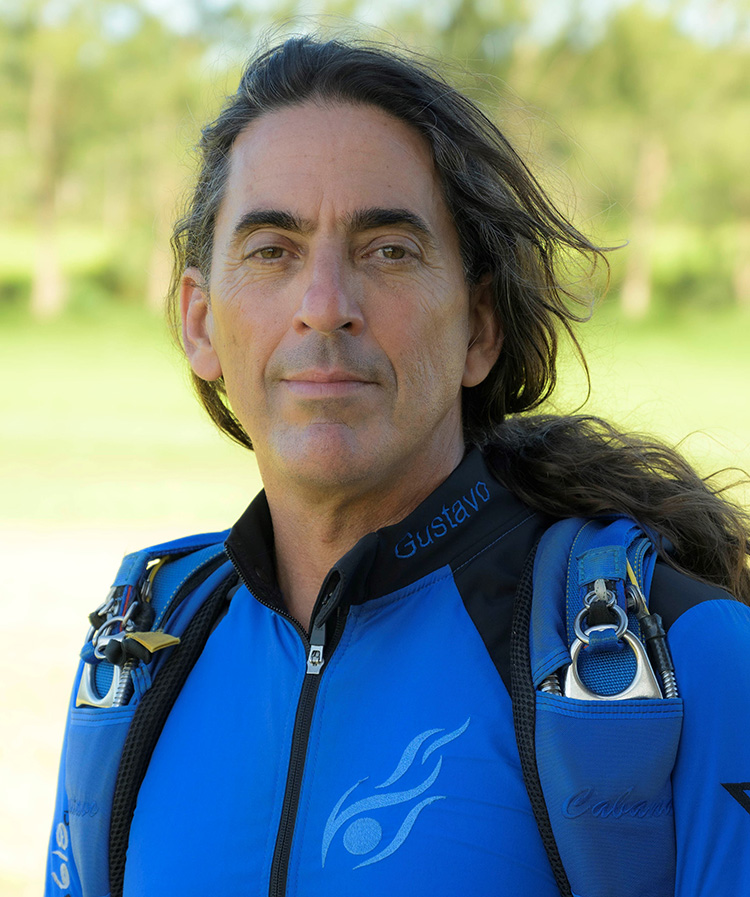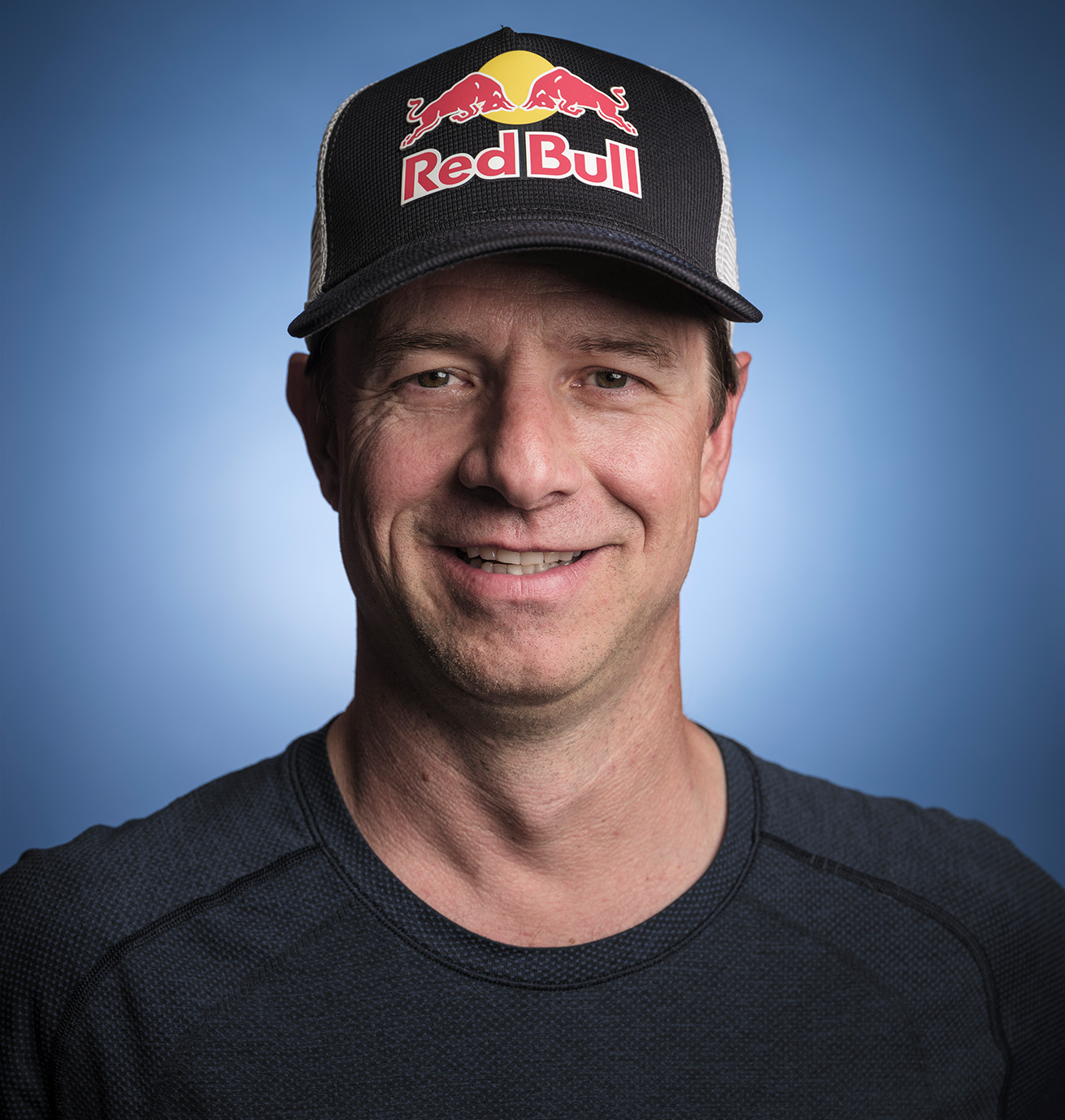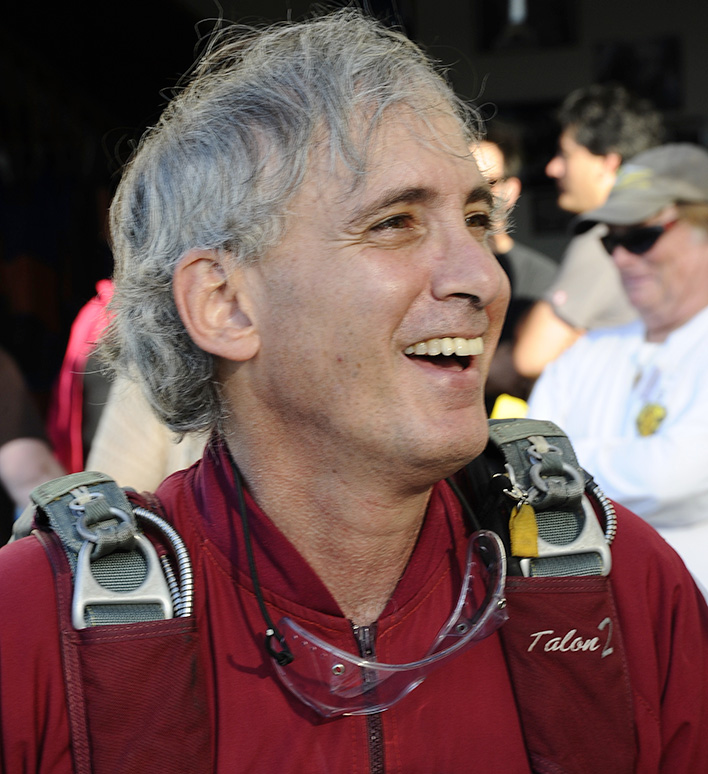Above photo: Past inductees gather for a group photo in their dark blue Hall of Fame blazers. Photo by Randy Forbes.
Each year the International Skydiving Museum anoints an elite few who have “defined, promoted, inspired and advanced the sport at the highest levels” into its Hall of Fame. This year’s class—just five inductees—is a group that embodies the spirit of our sport: An Argentinian with perhaps more camera jumps than anyone in the world, the founder of one of the largest and most successful canopy manufacturing companies, a freefly developer who also specialized in choreographing and filming movie and TV skydiving scenes, the primary inventor and developer of indoor skydiving, and a cofounder of one of the world’s most influential skydiving teams. 
Other awards slated for this year’s event include the Pioneers of Excellence Award, which the museum will present to the U.S. Army Golden Knights Competition Parachute Teams; and the Path of Excellence Award, which is going to Skydivers Over Sixty, a subgroup of the Parachutists Over Phorty Society that manages a robust age-group records program.
The induction ceremony and the accompanying gala will take place October 5-7 at Skydive Arizona, located in Eloy, the heart of the scenic Sonoran Desert midway between Phoenix and Tucson. Drop zone founders Larry and Liliane Hill started their skydiving business 45 years ago at a gravel airstrip north of Phoenix with a single Cessna 182. As their operation grew, they moved to Coolidge. Soon they had four Cessnas, four Twin Beeches, and two DC-3s. Today, their Eloy fleet is led by five Super Twin Otters and seven Skyvans. (A DC-3, once the workhorse of the fleet, carries an occasional load of 43 jumpers.) Altogether, these airplanes can put more than 240 skydivers in the air at one time, handling about 500 jumps an hour.
The celebration weekend will include various jumps, including the fan-favorite 10-Way STAR WARS, a speed formation skydiving competition. This year, the event will give a nod to history by having the traditional star (aka round) formation take place out of a DC-3. In addition, synchronized pairs of swoopers will demonstrate their skills across Skydive Arizona’s pond and, between each round, classic accuracy jumpers will aim for a tuffet. There will be two forums that are sure to captivate the audience: A Tribute to Joe Kittinger with Alan Eustace and Art Thompson; and Triple 7—Seven Continents, Seven Skydivers, Seven Days. And, this year, the Friday evening Path of Excellence Barbeque and Tribute will include the Indigenous Enterprise Dance Troupe, which will entertain the audience with a dynamic and captivating performance of pow-wow song and dance. The evening will close with the International Skydiving Museum & Hall of Fame Demo Team making the Path of Excellence tribute jump with pyrotechnics that will light up the sky.
Of course, in addition to the skydiving events and exhibits, the annual Saturday night banquet at the nearby Chandler Marriott Hotel will honor the new inductees into the Hall of Fame. Per tradition, they will don blue blazers signifying their achievement. The five incoming members of the 14th class of honorees bring this exclusive group to a total of 102 outstanding representatives of sport parachuting.
The Hall of Fame will be located in the International Skydiving Museum, which will be built on land already purchased in the Orlando, Florida area. With many interactive exhibits, it promises to showcase our sport to people who have never jumped out of a plane ... but perhaps will be encouraged to try.
In alphabetical order, the 2022 inductees are:
 Photo by Mariana Franceschetto.
Photo by Mariana Franceschetto.Gustavo Cabana
Cabana made his first skydive at 22. Only 70 jumps later, he strapped a VHS camcorder on his chest and a camera on his helmet to film his friends. Parachuting soon became his passion, his lifestyle and his profession. He now has more than 27,000 jumps from behind a lens, shooting all types of skydives during competitions, training camps, demos, boogies and expeditions, as well as for commercials and photo and video productions.
Shooting big-ways became Cabana’s specialty, and he’s documented a total of 29 Fédération Aéronautique Internationale World Records. He’s the only camera flyer who filmed largest formation world records in four disciplines: the 400-way formation skydive, the head-down 168-way formation skydive, the head-up 84-way formation skydive and the canopy formation 100-way. Many of those records could not have been attempted without his engineering skills. He designed, built and managed a high-altitude oxygen system for a fleet of seven aircraft at the Empuriabrava Challenge in Spain in 2013, which allowed skydivers to break multiple records, including when jumpers built four 106-way sequential world records and the biggest European head-down skydive to date: a 98-way.
Cabana began training camera flyers in 1998, and he has held seminars at several Parachute Industry Association Symposiums. His camera school is aimed at promoting safer skydiving at all levels. Besides his home country of Argentina, he has skydived in 27 others.
William “Bill” Coe
Bill Coe, founder of Performance Designs (PD), made his first skydive in 1976 at age 18 under a T-10 military surplus round canopy. While working part-time as a truck loader in Illinois in the winter, Coe decided to get out of the cold. In 1977, he moved to Daytona Beach, Florida, where he attended Embry-Riddle Aeronautical University to study aircraft mechanics and maintenance. After earning his aviation degree, Coe worked for Eastern Airlines in Miami. When he saved enough money, he began building his own parachutes.
By 1982, he founded PD with the primary goal of producing the best ram-air sport parachutes possible. A year later, after already building the PD nine-cell, he opened his shop near Skydive DeLand. In 1984, he and his partner, John LeBlanc, a classmate from Embry-Riddle, moved the firm to Miami.
Their parachutes revolutionized the business and today are recognized as a standard-bearer for the sport. Coe and his team developed and patented several widely used improvements to parachutes, including Microlines (low-drag suspension lines), soft-link connectors (Slinks), cross-bracing (both external and internal) and low-porosity fabric (zero p)—now the industry standard on most parachutes today. In 2007, PD released the Optimum reserve that uses a low-bulk fabric, allowing the packing of larger canopies into small containers. In the past 35 years, PD has become an international company with more than 300 employees and 300-plus varieties of canopies for student jumpers to competition pilots.
 Photo courtesy of Red Bull.
Photo courtesy of Red Bull.Jon Devore
Devore made his first skydive, a tandem, in 1993 in his hometown of Juneau, Alaska. That day, he knew he found his true passion. The next year he moved to Skydive Arizona to pursue his dream of earning a living in the sport. Devore became a professional skydiver and camera flyer and logged more than 22,000 jumps. Early on, he helped to develop and promote what is now known as freeflying, and became a two-time world champion and three-time national champion. Devore was one of the first full-time freefly coaches in the sport, and along with his team, Alchemy, organized multiple freefly world record attempts.
Devore has dedicated a large part of his career to coordinating skydiving demos and live shows all over the world. He has been the aerial coordinator of the Red Bull Air Force stunt team for more than 20 years. He also has participated in several major Hollywood films, TV shows and commercials as a stunt coordinator, stunt performer and aerial cinematographer. Devore’s credits include “Batman,” “Godzilla,” “Fast and Furious 7,” “Point Break,” “The Hangover Part III,” “Transformers: Dark of the Moon,” “Iron Man” and “Iron Man 3.” His most recent film work was on “Mission Impossible 7.”
Bill Kitchen
Outside of skydiving, Kitchen, now 75, is widely known as an inventor of the most exciting and innovative amusement rides and attractions in the world. You can ride them in such venues as Six Flags, Paramount, Cedar Fair parks and Orlando’s Fun Spot, as well as other amusement parks in several countries. Kitchen, however, is a Hall of Fame choice largely because he revolutionized indoor skydiving.
He made his first jump, a tandem, in 1990 from a Beech 18 in Ft. Collins, Colorado. He soon completed accelerated freefall training and went on to earn a PRO rating. To improve his flying skills, Kitchen went to a wind tunnel in Pigeon Forge, Tennessee, where he immediately noticed a deficiency—the air flow was not smooth as it is when freefalling from a plane—and he bruised himself slipping off the air column on the edge of the flight area.
His imagination and engineering—nurtured in high school where he was president of the Rocket Club and the Amateur Radio Club—inspired Kitchen to invent a vertical wind tunnel that more closely simulated real freefall. Along with a team of engineers and skydivers, he developed SkyVenture, an indoor skydiving attraction. The cost was a 10th of what his competitors expected him to spend. That first tunnel (now renamed iFLY) was immediately profitable, and it wasn’t long before skydiving teams booked block tunnel time on a regular basis. In addition, millions of non-jumpers were introduced to the thrill of freefall, and many went on to become skydivers. Kitchen began selling SkyVentures worldwide to drop zones, individual entrepreneurs and governments, eventually selling the company. SkyVenture and iFly continue to operate successfully in almost 100 locations worldwide.
Shannon Pilcher
Pilcher, D-18803, made his first jump in 1991 after a friend convinced him to try it, and he now has more than 24,000 skydives. After only 26 skydives, he began training in 4-way formation skydiving and soon thereafter began competing on a college team for Georgia Tech. Pilcher became a two-time 4-way world champion, educator and entrepreneur who has spent 27 years traveling to drop zones and teaching the sport. He has coached hundreds of jumpers in the science and art of 4-way.
Pilcher also became an expert canopy pilot. As a co-founding member of the Performance Designs Factory Team, Pilcher amassed three world records and numerous world medals. Also, with the PD team, he co-pioneered descents of some of the world’s most iconic mountain peaks, including the Italian Dolomites, French Alps, Norwegian fjords, the Grand Canyon and the Nepali Himalayas. After Pilcher’s team won world titles in 2004 and 2006, he co-founded a company that provides parachute training for top-tier military units worldwide. As a co-founding member of PD’s Flight-1, he has taught thousands of civilian and military canopy pilots, helping to usher in a paradigm-shifting culture of canopy safety around the world.
 About the Author
About the Author
Doug Garr, D-2791, is an author and journalist who made his first jump in 1969. He has written every Hall of Fame article for Parachutist since the first one, 14 years ago.